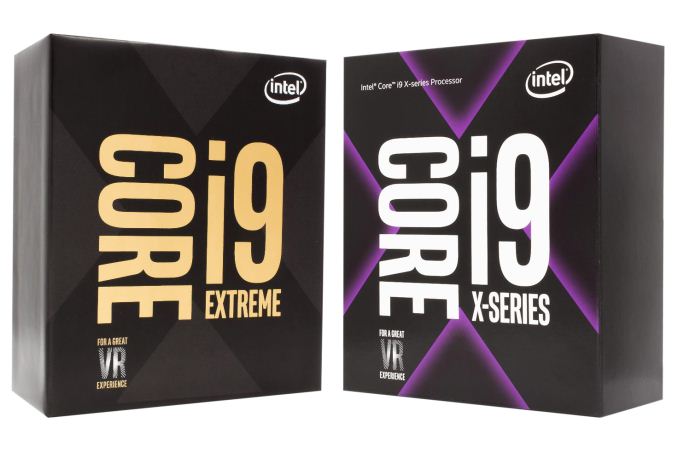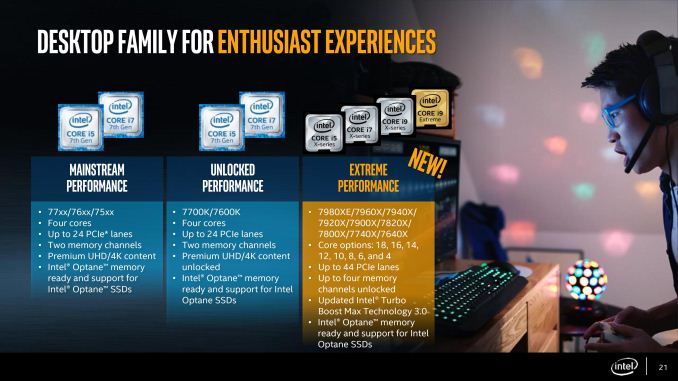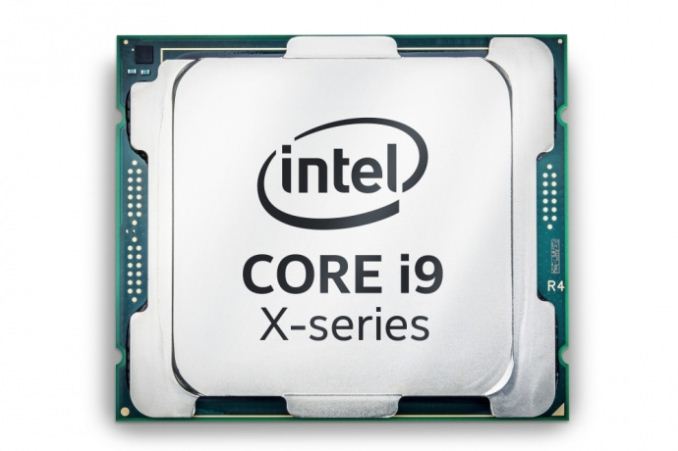Intel Announces Skylake-X: Bringing 18-Core HCC Silicon to Consumers for $1999
by Ian Cutress on May 30, 2017 3:03 AM EST
There are days in this profession in which I am surprised. The longer I stay in the technology industry, they become further and further apart. There are several reasons to be surprised: someone comes out of the blue with a revolutionary product and the ecosystem/infrastructure to back it up, or a company goes above and beyond a recent mediocre pace to take on the incumbents (with or without significant financial backing). One reason is confusion, as to why such a product would ever be thought of, and another is seeing how one company reacts to another.
We’ve been expecting the next high-end desktop version of Skylake for almost 18 months now, and fully expected it to be an iterative update over Broadwell-E: a couple more cores, a few more dollars, a new socket, and done. Intel has surprised us with at least two of the reasons above: Skylake-X will increase the core count of Intel’s HEDT platform from 10 to 18.
The Skylake-X announcement is a lot to unpack, and there are several elements to the equation. Let’s start with familiar territory: the first half of the processor launch.
Announcement One: Low Core Count Skylake-X Processors
The last generation, Broadwell-E, offered four processors: two six-core parts, an eight-core part, and a top-tier 10-core processor. The main difference between the two six-core parts was the PCIe lane count, and aside from the hike in pricing for the top-end SKU, these were iterative updates over Haswell-E: two more cores for the top processor.
This strategy from Intel is derived from what they call internally as their ‘LCC’ core, standing for ‘low core count’. The enterprise line from Intel has three designs for their silicon – a low core count, a high core count, and an extreme core count: LCC, HCC, and XCC respectively. All the processors in the enterprise line are typically made from these three silicon maps: a 10-core LCC silicon die, for example, can have two cores disabled to be an 8-core. Or a 22-core XCC die can have all but four cores disabled, but still retain access to all the L3 cache, to have an XCC processor that has a massive cache structure. For the consumer HEDT platform, such as Haswell-E and Broadwell-E, the processors made public were all derived from the LCC silicon.
The first half of the Skylake-X processor llineup follows this trend. Intel will launch four Skylake-X processors based on the LCC die, which for this platform will have a maximum of 12 cores. All processors will have hyperthreading.
| Skylake-X Processors (Low Core Count Chips) | ||||
| Core i7-7800X | Core i7-7820X | Core i9-7900X | Core i9-7920X | |
| Cores/ Threads |
6/12 | 8/16 | 10/20 | 12/24 |
| Base Clock | 3.5 GHz | 3.6 GHz | 3.3 GHz | TBD |
| Turbo Clock | 4.0 GHz | 4.3 GHz | 4.3 GHz | TBD |
| TurboMax Clock | N/A | 4.5 GHz | 4.5 GHz | TBD |
| L3 | 8.25 MB | 11 MB | 13.75 MB | TBD (Likely 13.75 MB) |
| PCIe Lanes | 28 | 44 | TBD (Likely 44) |
|
| Memory Channels | 4 | |||
| Memory Freq | DDR4-2400 | DDR4-2666 | TBD | |
| TDP | 140W | TBD | ||
| Price | $389 | $599 | $999 | $1199 |
The bottom processor is the Core i7-7800X, running at 3.5 GHz with a 4.0 GHz turbo. This design will not feature Intel’s new ‘favored core’ Turbo 3.0 technology (more on that below), but will have six cores, support quad-channel memory at DDR4-2400, come in at a TDP of 140W, have 28 PCIe lanes, and retail for around $400. This processor will be the entry level model, for any user who needs the benefit of quad-channel memory but perhaps doesn’t need a two-digit number of cores or has a more limited budget.
Next up is the Core i7-7820X, which hits a potential sweet spot in the LCC design. This is an eight-core processor, with the highest LCC base clock of 3.6 GHz and the joint-highest turbo settings: 4.3 GHz for regular turbo and 4.5 GHz for favored core. Unlike the previous processor, this CPU gets support for DDR4-2666 memory.
However in another break from Intel’s regular strategy, this CPU will only support 28 PCIe lanes. Normally only the lowest CPU of the HEDT stack would be adjusted in this way, but Intel is using the PCIe lane allocation as another differentiator as a user considers which processor in the stack to go for. This CPU also runs in at 140W, and comes in at $600. At this price, we would expect it to be competing directly against AMD’s Ryzen 7 1800X, which will be the equivalent of a generation behind in IPC but $100 cheaper.
| Comparison: Core i7-7820X vs. Ryzen 7 1800X | ||
| Intel Core i7-7820X |
Features | AMD Ryzen 7 1800X |
| 8 / 16 | Cores/Threads | 8 / 16 |
| 3.6 / 4.3GHz (4.5 GHz TMax) |
Base/Turbo | 3.6 / 4.0 GHz |
| 28 | PCIe 3.0 Lanes | 16 |
| 11 MB | L3 Cache | 16 MB |
| 140 W | TDP | 95 W |
| $599 | Price (MSRP) | $499 |
The third processor is also a change for Intel. Here is the first processor bearing the new Core i9 family. Previously we had Core i3, i5 and i7 for several generations. This time out, Intel deems it necessary to add another layer of differentiation in the naming, so the Core i9 naming scheme was the obvious choice. If we look at what the Core i9 name brings to the table, the obvious improvement is PCIe lanes: Core i7 processors will have 28 PCIe lanes, while Core i9 processors will have 44 PCIe lanes. This makes configuring an X299 motherboard a little difficult: see our piece on X299 to read up on why.
Right now the Core i9-7900X is the only Core i9 with any details: this is a ten core processor, running with a 3.3 GHz base, a 4.3 GHz turbo and a 4.5 GHz favored core. Like the last processor, it will support DDR4-2666 and has a TDP of 140W. At this level, Intel is now going to charge $100/core, so this 10-core part runs in at a $999 tray price ($1049 retail likely).
One brain cell to twitch when reading this specification is the price. For Ivy Bridge-E, the top SKU was $999 for six-cores. For Haswell-E, the top SKU was $999 for eight-cores. For Broadwell-E, we expected the top SKU for 10-cores to be $999, but Intel pushed the price up to $1721, due to the way the enterprise processors were priced. For Skylake-X, the new pricing scheme is somewhat scrapped again. This 10-core part is now $999, which is what we expected the Broadwell-E based Core i7-6950X to be. This isn’t the top SKU, but the pricing comes back down to reasonable levels.
Meanwhile for the initial launch of Skylake-X, it is worth noting that this 10-core CPU, the Core i9-7900X, will be the first one available to purch. More on that later.
Still covering the LCC core designs, the final processor in this stack is the Core i9-7920X. This processor will be coming out later in the year, likely during the summer, but it will be a 12-core processor on the same LGA2066 socket for $1199 (retail ~$1279), being part of the $100/core mantra. We are told that Intel is still validating the frequencies of this CPU to find a good balance of performance and power, although we understand that it might be 165W rather than 140W, as Intel’s pre-briefing explained that the whole X299 motherboard set should be ready to support 165W processors.
In the enterprise space, or at least in previous generations, Intel has always had that processor that consumed more power than the rest. This was usually called the ‘workstation’ processor, designed to be in a single or dual socket design but with a pumped up frequency and price to match. In order for Intel to provide this 12-core processor to customers, as the top end of the LCC silicon, it has to be performant, power efficient, and come in at reasonable yields. There’s a chance that not all the factors are in place yet, especially if they come out with a 12-core part that is clocked high and could potentially absorb some of their enterprise sales.
Given the expected timing and launch for this processor, as mentioned we were expecting mid-summer, that would have normally put the crosshairs into Intel’s annual IDF conference in mid-August, although that conference has now been canned. There are a few gaming events around that time to which Intel may decide to align the launch to.












203 Comments
View All Comments
Strunf - Tuesday, May 30, 2017 - link
"even if manages to take tangible lead against a 16 core threadripper, it will not be worth the money." on this market niche money means nothing... AMD needs to have a 10%+ performance advantage to be considered cause Intel has a much better brand value, if anything the 16 core Threadripper is a desperate attempt by AMD to actually gain some traction on the HEDT.About the thermal limit, yes there's a wall but with the new Turbo the two best cores of a CPU can be clocked higher than the rest and hence give you better single thread performance when need, this is the future no doubt about it.
You guys need to realize it's not cause AMD releases a product that is better on all metrics that everyone will shift to AMD, brand value counts and in the case of CPU the motherboard matters too, sure AMD has some nice motherboards but overall the Intel motherboards seem to be better furnished albeit at a higher cost.
ddriver - Tuesday, May 30, 2017 - link
Sure, intel's high prices are justified by several things:corporate brand loyalty
amd's limited production capacity
fanboyism
But all in all, money is EVERYTHING, the whole industry cares primarily about one thing, and that's profit. There is absolutely no good reason to pay 100% more for 10% more. I mean not unless someone else does the actual paying.
Only an idiot would care about "brand value". Computers are supposed to do work, not make up for your poor self-esteem. Any intelligent person who needs performance would put his money where he'd get the most bang for the buck. Workstation grade workloads render particularly well to multithreading but also to clustering. So if you want more performance, the smart solution is to aim for the best price/performance product, and get a lot of it, rather than getting the single most expensive product.
AMD is not desperately trying anything. It's desktop line pretty much annihilated intel's existing HEDT offerings at significantly lower price points. It is intel desperately trying to not lose the HEDT market to AMD's mainstream offerings. They'd rather throw in a couple of extra cores even if it makes zero sense, just to not disillusion their fanboys.
I am not speaking of any brand loyalty point, I have like 70 active systems and they all run intel CPUs. I am however very happy and eager to diversify and replace most of those, which are aging 3770k chips with something that offers higher performance and better power/performance ratio.
Hxx - Tuesday, May 30, 2017 - link
well, first off general comments have no place in the tech industry due to the variety of use cases and products. Folks care about brand value on certain items , say motherboard brands but not so much maybe on CPUs.Second, AMD did not annihilate Intel by any stretch of the imagination. where do u guys get this info? Probably from wccftech.com . Anyway their ryzen release is solid but they need cpus with higher IPCs or higher than Intel which they currently don't have.
Third, I'm not sure what you mean by intel and desperately but there is nothing desperate about this current announcement. CPUs don't take 2 months to develop. Its not like Intel said in response to Ryzen "oh yeah? lets build a better cpu". these cpus have been fully developed and waiting retail release, maybe Ryzen pushed them to prioritize this release but these were not build as a "response to Ryzen" by any means.
ddriver - Tuesday, May 30, 2017 - link
Ryzen offered intel's E series of performance at half the cost. That's twice the value. You don't need imagination, much less to stretch it, to realize that 100% better value is tad amount to annihilation. This is over-exponated by the fact it was mainstream CPUs against premium HEDT.And YES, it is desperation, because this product was never intended for HEDT, this is not a case of intel holding a trump card just in case amd finally decides to stop sitting on its hands. The 18 core chip was intended for server parts, and its arrival is exactly on time to be directly caused by the Ryzen launch. Intel simply too a server part with some deffective or disabled cores, in order to gain TDP headroom to boos the clocks of the remaining cores higher. It is not like intel sat down and "let's design a whole new chip in response to ryzen" - that would take significantly more time, they simply took a server part, crippled it a bit, overclocked it a bit, just so they can have a HEDT product with 2 more cores, and in doing so, sacrificing the amount of money they will make on that chip just to save face, as it would have been significantly more expensive as a xeon branded product.
Had amd not launched ryzen, intel's current gen HEDT would have capped out at 12 cores. The 18 core solution is a last resort, last moment solution, and not too economically viable either. So yeah, it is desperation.
But then again, expecting someone who cannot property format a paragraph to get common sense might be pushing it...
ddriver - Tuesday, May 30, 2017 - link
Keep in mind had not intel sacrificed xeons to make that 18 core chip, its HEDT line would have been stuck at 12 cores, meaning that threadripper would have made intel look like a second-class CPU maker in that segment.So yes, it is quite literally burning money to save face for intel.
Kjella - Tuesday, May 30, 2017 - link
Burning money? Ever since Bulldozer started lagging behind Intel has been printing money like crazy, this is just a return to normal profit margins because AMD is back on the field. Intel made $10 billion profit last year, I'm sure they'll survive this horrible "loss".ddriver - Wednesday, May 31, 2017 - link
The "desperation" is not for their survival, they survived the netburst fiasco when their product was marginally inferior.The desperation is to not look like a second grade choice in the HEDT market, thus sacrificing a much more profitable die to save face.
rocky12345 - Thursday, June 1, 2017 - link
"The "desperation" is not for their survival, they survived the netburst fiasco when their product was marginally inferior."Back in Netburst days AMD was a lot better with what they had to offer. Heck AMD CPU running at 2000Mhz was able to keep up to or surpass a Pentium 4 @3.2Ghz. It only got worse when dual core Ahtlon's came about and Intel had to make the Pentium 4 D's but still running much much faster clock rate just to stay in the game. Very few people seem to remember Intel had a lot of bad years as well. Pentium 4 series all sucked Donkey Nutz nuf said.
As others have said if AMD did not release Ryzen that competes nicely with Intel's HEDT platform at half the price then AMD say's oh we have a 16/32 Threadripper as well Intel would not be releasing the 18/36 CPU right now they would have kept that CPU in the Zeon line where they make the big bucks hell that 18 core is probably a cut down 20/40 Zeon retro fitted to be a X series chip. Anyways all this means it is good for us the consumers we get more choice and hopefully at a better price also.
ddriver - Friday, June 2, 2017 - link
Don't forget that with AMD you get marginally better value. So even if the 18 core intel HEDT chip is tangibly faster than the top tier threadripper, for 2000$ AMD could get you a 32 core Epyc that will beat the 18 core in performance, and pretty much every other chip intel have at any price point.The 18 core number is also interesting as AMD's design is practically incapable of efficiently producing such a SKU, so even if intel don't get the fastest single chip, they will still be technically getting the performance crown in HEDT, albeit with a server chip they shoehorned there, and with a unique core count that AMD cannot exactly match, even if they can significantly outmatch.
Azethoth - Tuesday, May 30, 2017 - link
Dude, you are missing an opportunity to really diss Intel here. Why just compare AMD to the last gen Intel chips from many years ago when you can go back decades!Compare to the pentium. Then you can claim that AMD annihilated Intel, scraped up the ashes then decimated those, then threw them in the microwave and nuked them before getting hookers to pee on the dust and leaving it out to blow around in the sun and wind!
As it is your post is too weak to take seriously.